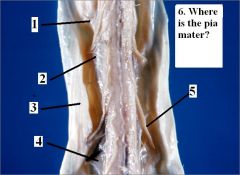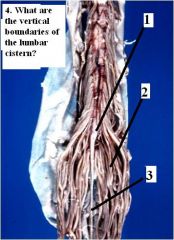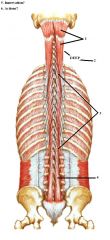![]()
![]()
![]()
Use LEFT and RIGHT arrow keys to navigate between flashcards;
Use UP and DOWN arrow keys to flip the card;
H to show hint;
A reads text to speech;
65 Cards in this Set
- Front
- Back
|
1. Denticulate ligament
2. Arachnoid 3. Dura Mater 4. Denticulate ligament 5. Anterior root of spinal nerve 6. Covers the surface of spinal cord. |

Spinal Cord Meninges Anterior View
|
|
|
1. Conus Medullaris
2. Cauda Equina 3. Filum Terminale 4. L2 to S2 |

Identify and answer
|
|
|
How does the Filum Terminale attach to the coccyx?
|
Via Coccygeal ligament
|
|
|
In adult spinal cord, where does it end?
|
Between L1 and L2
|
|
|
In adult spinal cord, where is the conus medullaris located?
|
Between L1 and L2
|
|
|
In adults, a lumbar puncture would be ideal where?
|
Between L3 and L4
or between L4 and L5 |
|
|
In newborns, the spinal cord ends where?
|
At L3 Vertebrae
|
|
|
In newborns, where would it be ideal to perform a lumbar puncture?
|
At a lower level than L3
|
|
|
Define Scoliosis.
|
Excessive lateral curvature
|
|
|
Define Kyphosis
|
Excessive thoracic curvature
|
|
|
Define Lordosis
|
Excessive lumbar curvature
|
|
|
How many cervical nerves?
|
8 nerves
|
|
|
How many thoracic nerves?
|
12 nerves
|
|
|
How many lumbar nerves?
|
5 nerves
|
|
|
How many sacral nerves?
|
5 nerves
|
|
|
How many coccygeal nerves?
|
1 nerve
|
|
|
What are the movements of the cervical vertebrae?
|
Flexion
Extension Lateral Flexion Rotation |
|
|
What are the movements of the thoracic vertebrae?
|
Rotation only
|
|
|
What are the movements of the lumbar vertebrae?
|
Flexion
Extension Lateral flexion |
|
|
What are the movements of sacral vertebrae?
|
None
|
|
|
What are the movements of the coccygeal vertebrae?
|
None
|
|
|
1. Bifid Spinous Process
2. Superior articular facet 3. Transverse process 4. Upper Cervical b/c of Bifid spinous process and transverse process 5. Lower Cervical b/c of no bifid spinous process, but existing transverse process. |

ID and Answer
|
|
|
1. Inferior Articular Facet
2. Superior Articular Facet 3. Joint Capsule 4. Zygapophysial joint |

ID and Answer
|
|
|
1. Annulus Fibrosis
2. Nucleus Fibrosis (soft) |

ID
|
|
|
What type of connective tissue surrounds the articular disc on both top and bottom?
|
Hyaline cartilage
|
|
|
What type of connective tissue is the articular disc made of?
|
Fibrocartilage
|
|
|
Where is the nucleus pulposus derived from?
|
Embryological notochord
|
|
|
Herniated disc
|

Answer
|
|
|
Most herniated discs occur where?
|
Between L4 and L5
or between L5 and S1 |
|
|
What do herniated discs do?
|
Impinge on the nerve roots, most likely the L5 and S1 nerve roots.
|
|
|
Where would you find uncovertebral joints?
|
Between C3 to C6, on the lateral edge of articular disc at the uncinate process.
|
|
|
At the uncovertebral joint, what is the orientation of the articular disc?
|
Retracted
|
|
|
At the uncovertebral joint, the edge is lined by what?
|
Hyaline cartilage only.
|
|
|
What area is frequent site of bone spurs causing neck pain?
|
C3 to C6, at the uncovertebral joint.
|
|
|
What is the intervertebral disc between the C1 and C2 called?
|
There is no intervertebral disc there.
|
|
|
What is the joint responsible for the rocking motion assoicated with nodding "yes."
|
Atlanto-occipital joint
|
|
|
What is the joint responsible for the shaking motion associated with shaking "no."
|
Atlanto-axial joint
|
|
|
1. Anterior Longitudinal Ligaments
2. Posterior Longitudinal ligament 3. Ligamentum Flavum 4. Interspinous ligament 5. Supraspinous ligament |

ID
|
|
|
Ligamentum Nuchae
|

ID
|
|
|
Extrinsic muscles of the upper extremity and the respiratory muscles are innervated by what?
|
Ventral rami.
|
|
|
What is the only upper extremity back muscle not innervated by the ventral rami?
|
Trapezius (CN XI spinal accessory nerve)
|
|
|
Intrinsic muscles moving the vertebral column is innervated by what?
|
Dorsal rami
|
|
|
Give the segmental arteries supplying the back. x3
|
1. Aorta
2. Vertebral artery 3. Internal iliac artery |
|
|
What does the dorsal scapular nerve innervate in the upper extremity, extrinsic muscles? x2
|
Levator Scapulae
and Rhomboids (major and minor) |
|
|
The upper extremity, extrinsic muscle --> trapezius, is innervated by what nerve?
|
Spinal accessory nerve
|
|
|
The EXTRINSIC MUSCLES of the UPPER EXTREMITY is innervated by what?
|
Ventral Rami of the Brachial Plexus
|
|
|
The EXTRINSIC MUSCLES responsible for RESPIRATORY is innervated by what?
|
Ventral Rami of the Thoracic Cord
|
|
|
Intrinsic muscles move what?
|
It moves the vertebral column
|
|
|
What is the origin of the Splenius?
|
Spinous process
Capitis (ligamentum nuchae) Cervicus (T1-T6) |
|
|
What is the insertion of the splenius?
|
Skull (capitus)
Transverse process (cervicis) |
|
|
What is the actions of the splenius? x2
|
Extend & Rotate head
|
|
|
What innervates the splenius?
|
Dorsal Rami
|
|
|
What is the common origin of the Erector Spinae muscles? x3
|
Illium,
Sacrum, Spinous Process (of lumbar and sacral vertebrae) |
|
|
What is the insertions of the erector spinae? x4
|
Spinous process
Transverse process Ribs Skull |
|
|
What is the innervation of the erector spinae?
|
Dorsal Rami
|
|
|
What are the general muscles of the erector spinae?
|
Spinalis
Longissimus Iliocostalis |
|
|
What erector spinae muscle inserts into the mastoid process?
|
Longissimus capitus
|
|
|
What are the actions of the erector spinae muscles? x3
|
Extend Head
Extend & Laterally Flex Spine |
|
|
What are the general Transversospinal muscles?
|
Semispinalis
Multifidi Rotatores |
|
|
1. Splenius Capitis
2. Splenius Cervicis 3. Spinous Processes 4. Transverse Process & skull 5. Extend and Rotate head 6. Dorsal Rami |

ID and answer
|
|
|
1. Spinalis Thoracis
2. Longissimus Thoracis 3. Intercostalis Lumborum 4. Longissimus Capitis 5. Longissimus Cervicis 6. Intercostalis Cervicis 7. Intercostalis Thorcis |

ID
|
|
|
1. Semispinalis Capitis
2. Semispinalis Cervicis 3. Semispinalis Thoracis 4. Multifidi 5. Dorsal Rami 6. Extend head and spine Rotate (twist) spine |

ID
|
|
|
1. Long Rotatores
2. Short Rotatores 3. Semispinalis 4. Multifidus |

ID
|
|
|
1. Interspinous
2. Levatores Costarum 3. Intertransverse |

ID
|
|
|
1. Rectus Capitis Posterior Minor
2. Rectus Capitis Posterior Major 3. Obliquus Capitis Superior 4. Obliquus Capitis Interior 5. Posterior Altanto-occipital membrane |

ID
|

